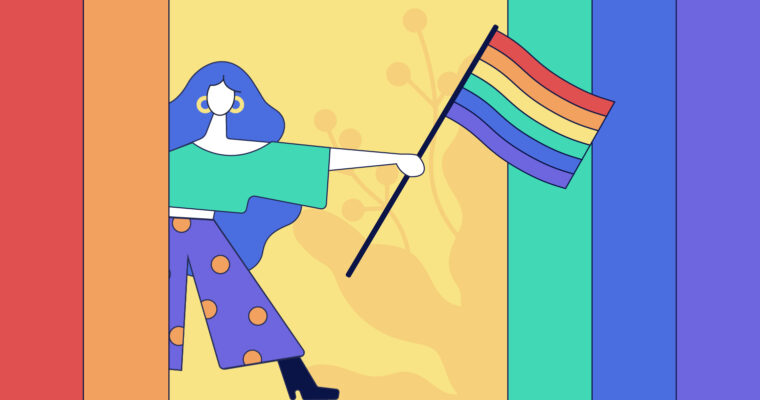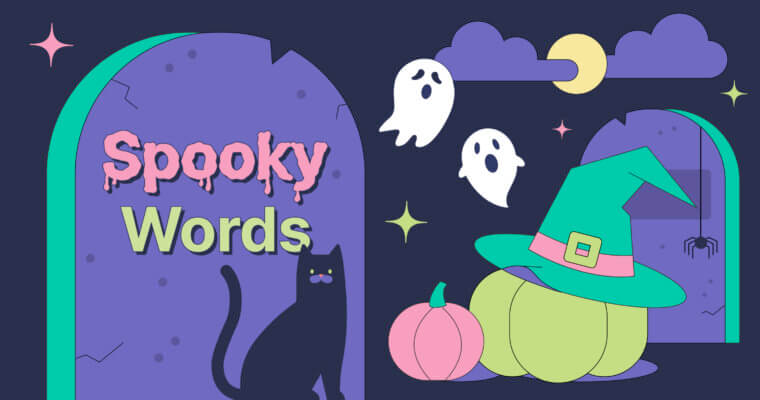
Pride Month holds a special place in Grammarly’s heart because it provides an opportunity to highlight understanding one another. We firmly believe language exists not to confuse, but to clarify, and that the education and understanding that language provides can bring us closer together and foster deeper empathy. We compiled a list of inclusive terms to help build that bridge.
Of course, while Grammarly and the queer colleagues who worked on this list are not the final word on the language of Pride (we recommend GLAAD and PFLAG for further resources), we wanted to provide a primer for anyone interested in understanding the complexity of identity and using inclusive language accordingly. Here are the terms we think are important to know if you’re looking to know more about gender and sexuality this Pride Month and beyond.
LGBTQIA+
This acronym, constantly being updated, refers to all of the identities commonly associated with gender and sexual identities that are outside of the heterosexual, cisgender norm. This iteration stands for Lesbian, Gay, Bisexual, Transgender, Queer, Intersex, Asexual, and more.
Queer
To some elders, this term harkens back to its time as a slur to refer to LGBTQIA+ individuals, while to others, it serves as a useful, reclaimed term to describe themselves or their community. Do not use this term to refer to anyone who does not use it to describe themselves.
>>READ MORE: The Language of Gender and Sexuality
Intersectionality
This term refers to the concept of interconnected areas of oppression, how they overlap and combine, and the idea that social justice doesn’t exist in a vacuum. Read Merriam-Webster’s entry to learn more about the term’s history and usage.
Attraction
Sexual orientation
Your sexual orientation is how you describe the way you experience physical attraction. Lesbian, gay, bisexual, pansexual, and asexual are all examples of these.
Romantic orientation
How you describe the way you experience emotional attraction. This may line up with your sexual orientation, but it may not. Panromantic and aromantic are examples of these terms.
Lesbian
This term refers to a woman who is sexually and/or romantically attracted to other women.
Gay
This term refers to a man sexually and/or romantically attracted to other men. It’s also sometimes used as a blanket term to refer to any person who is interested in the same gender as their own.
Bisexual
This term refers to a person attracted to two or more genders. This could be a person attracted to men and women, a person attracted to men and nonbinary genders, or a person attracted to their own gender and a few others. While “bi” does refer to two, as the community’s understanding of gender has grown, the term has expanded in its usage beyond the gender binary.
Pansexual
Similar to bisexual, a person attracted to many genders (usually more than two or any gender). Someone may consider themselves bisexual and pansexual, or just one or the other.
Questioning
A term used to refer to someone who is not sure what their gender identity or sexual orientation is, and who is in the process of figuring it out.
Straight/heterosexual
A man attracted to women, or a woman attracted to men. Cis and trans people can be heterosexual, as it’s about the gender you identify as and the gender you’re attracted to, not the one you were born with.
Asexual spectrum
Asexuality is the term for people who don’t experience sexual attraction, and the spectrum refers to different ways in which people experience less sexual attraction than the norm. Some people may only experience sexual attraction after many months or years of knowing someone, and some may never experience it. Some may be willing to engage in sexual activity even if it doesn’t interest them, and some may not.
Gender identity
Sex
Your sex is the biological combination of your bodily organs, hormones, and chromosomes. Sex and gender are associated, but not the same nor interchangeable.
Gender expression
Your gender expression is how you present yourself to the outside world, and how that links to the way you experience your own gender.
They/them/theirs
A set of gender-neutral pronouns used by some nonbinary or genderqueer people to identify themselves in the third person. See more about gender-neutral third-person pronouns in our blog on the subject.
>>READ MORE: The Singular They
Gender assigned at birth
This is the gender that gets assigned to you when you’re born, based on your sex organs and chromosomes.
Cisgender
Your experienced gender aligns with the gender you were assigned at birth.
Transgender
Your experienced gender is different than the one you were assigned at birth.
Nonbinary (or non-binary)
Your experienced gender doesn’t align with either traditionally assigned gender, only lines up with one of them sometimes, or aligns with both and more. The terms genderqueer and agender can have similar but more nuanced associations.
Gender nonconforming
Gender nonconforming is broader than nonbinary. It means your gender expression doesn’t correspond to your biological sex. You may still identify as a woman, but you may dress only in men’s clothes, for example, or you may present in a way that doesn’t align with society’s idea of male or female.
Agender
You experience no attachment to any gender.
Intersex
Your sexual organs don’t fall within the sexual binary. Read more about what it means to be intersex from the Intersex Society of North America.
Misgender
The act of misgendering someone is the act of deliberately or accidentally referring to someone by the wrong gender assignation.
Transition
Transition, for a trans person, could start and end with coming out as a new gender—or it could mean a life of gender-affirming hormone replacement therapy and surgery. Transition is a process, and it’s different for every trans person. No one needs to complete a specific set of steps to have transitioned.
Two-spirit
Native American identity in which one person contains female and male spirits within them. Learn more about the history of two-spirit identity.
Gender expansive
The feeling of expanding in your gender experience beyond current notions of gender identity, and not wanting to limit your identity to one or another.
Gender dysphoria
The feeling of your appearance or outside perception of yourself not matching your gender identity. This can be treated through transition, but trans people could experience this in different ways for their whole lives.
Being LGBTQIA+
Coming out
Coming out is a unique process for every LGBTQIA+ person. It’s not a requirement for any person to come out in public. Coming out, like all things, is a process—often the first time you come out to is yourself—and you may come out multiple times in your life as you meet new people and learn more about yourself.
Living openly
Living openly is the choice to live as your authentic self—to live as an LGBTQIA+ person in spite of harassment and oppression.
Outing
The practice of revealing someone else’s sexuality or gender identity without their consent.
Pride
A celebration of standing open in one’s own identity against oppression, beginning with the Stonewall Riots of 1969. From a time when gay and trans clubs were raided by police regularly to now, Pride Month is a celebration of how far we have come, a remembrance of where we came from, and a reminder of how far we have yet to go.
Ally
Someone who supports the rights of the LGBTQIA+ community through action. Find out more about how you can take action to support your LGBTQIA+ loved ones here.






